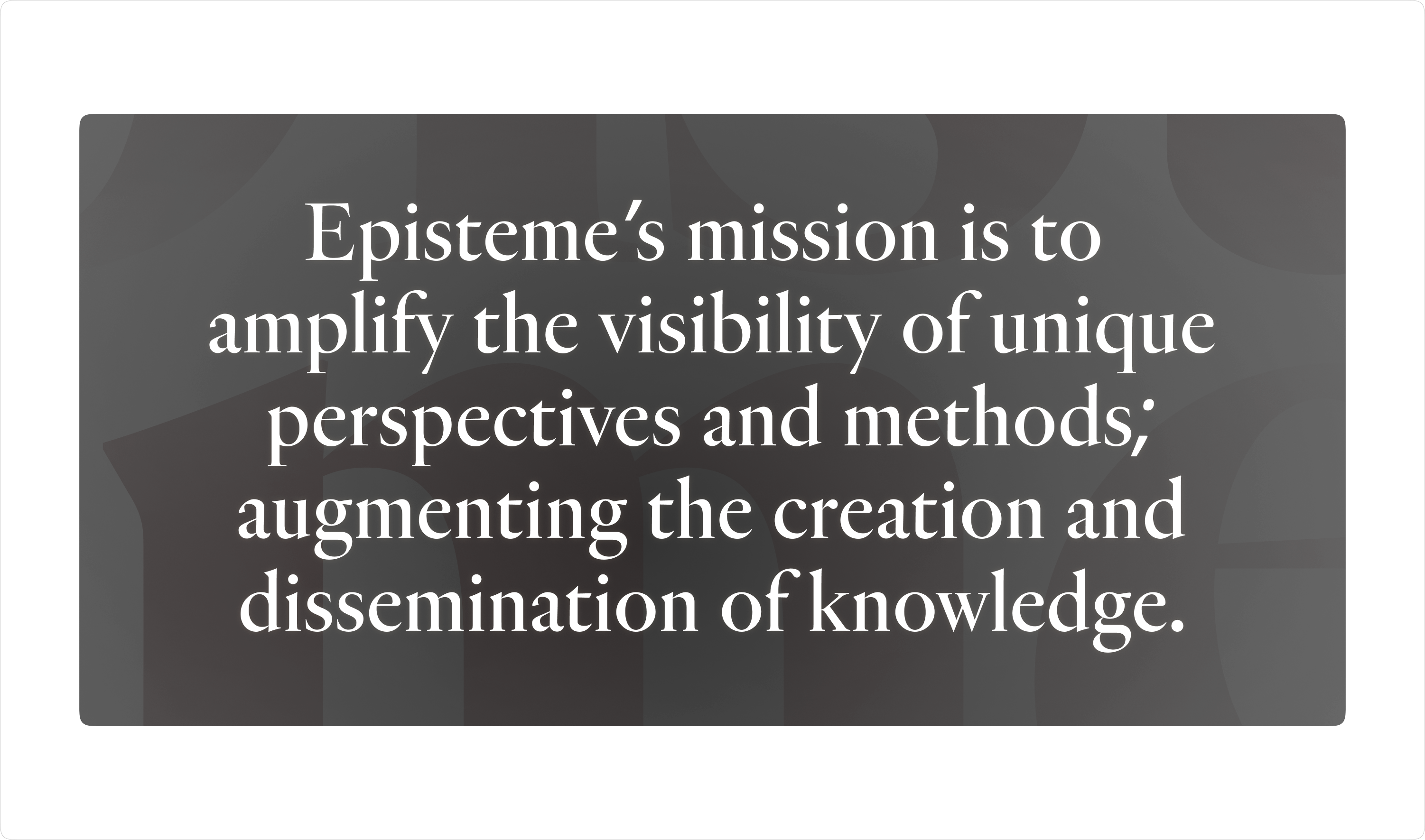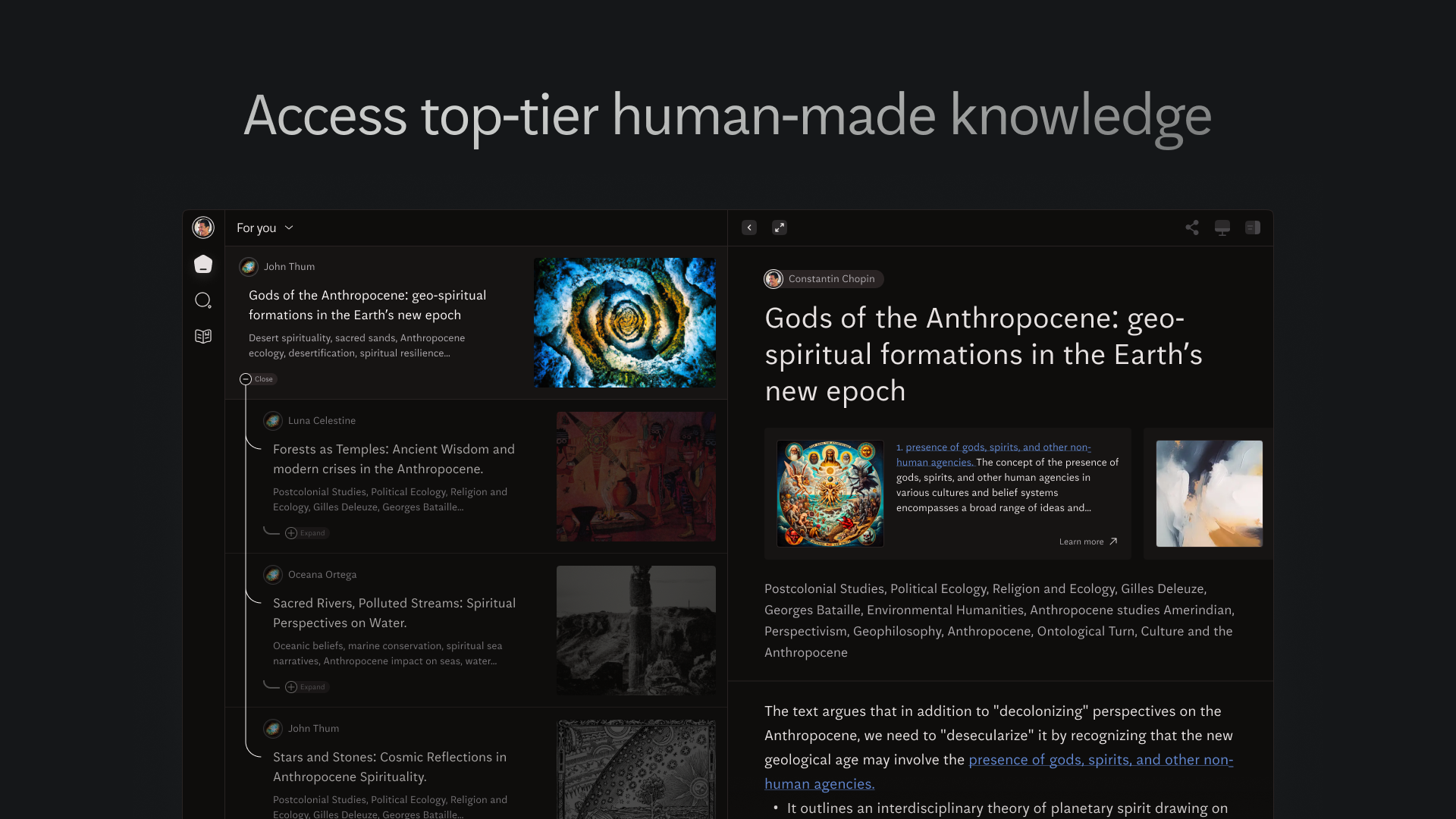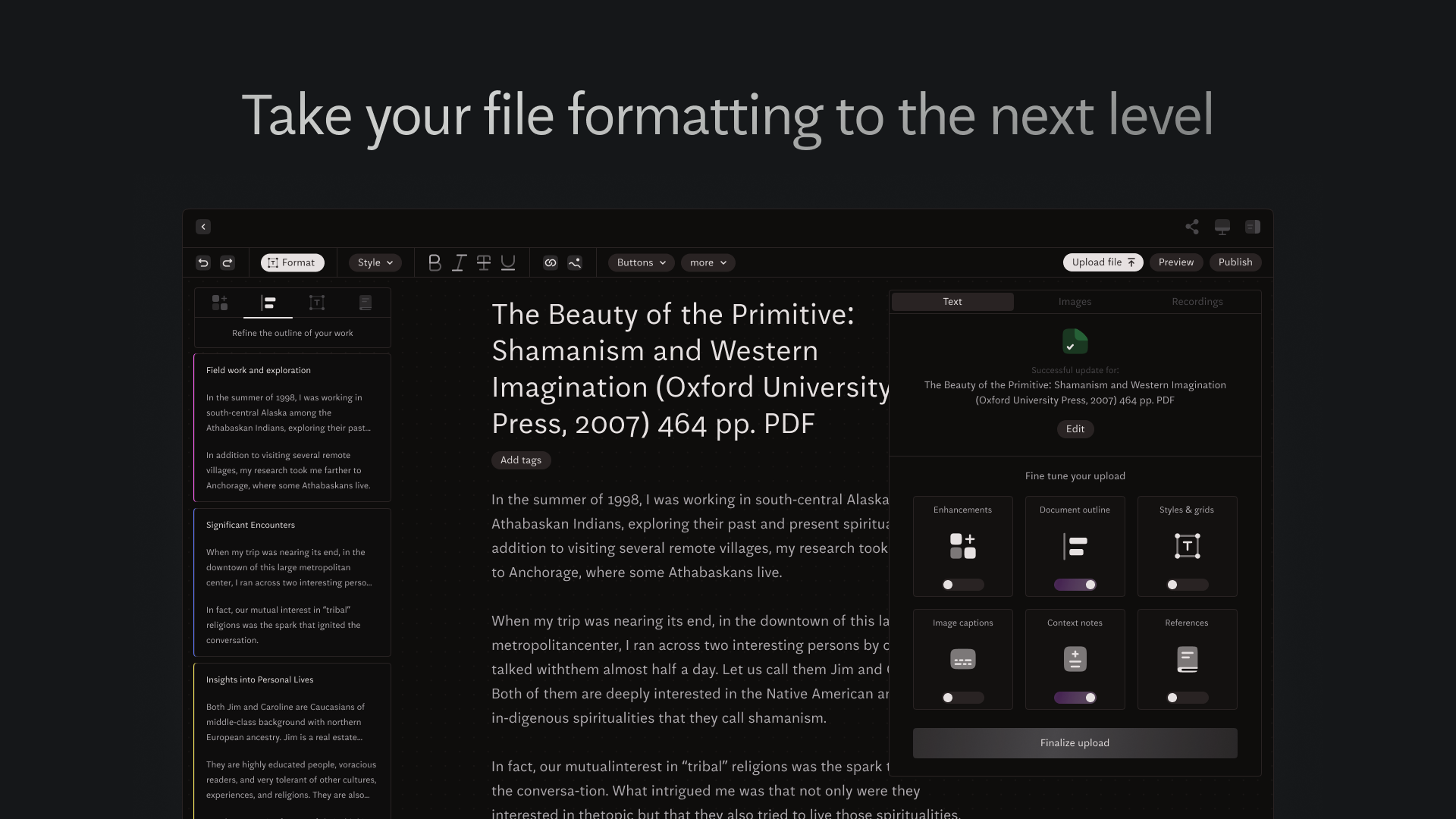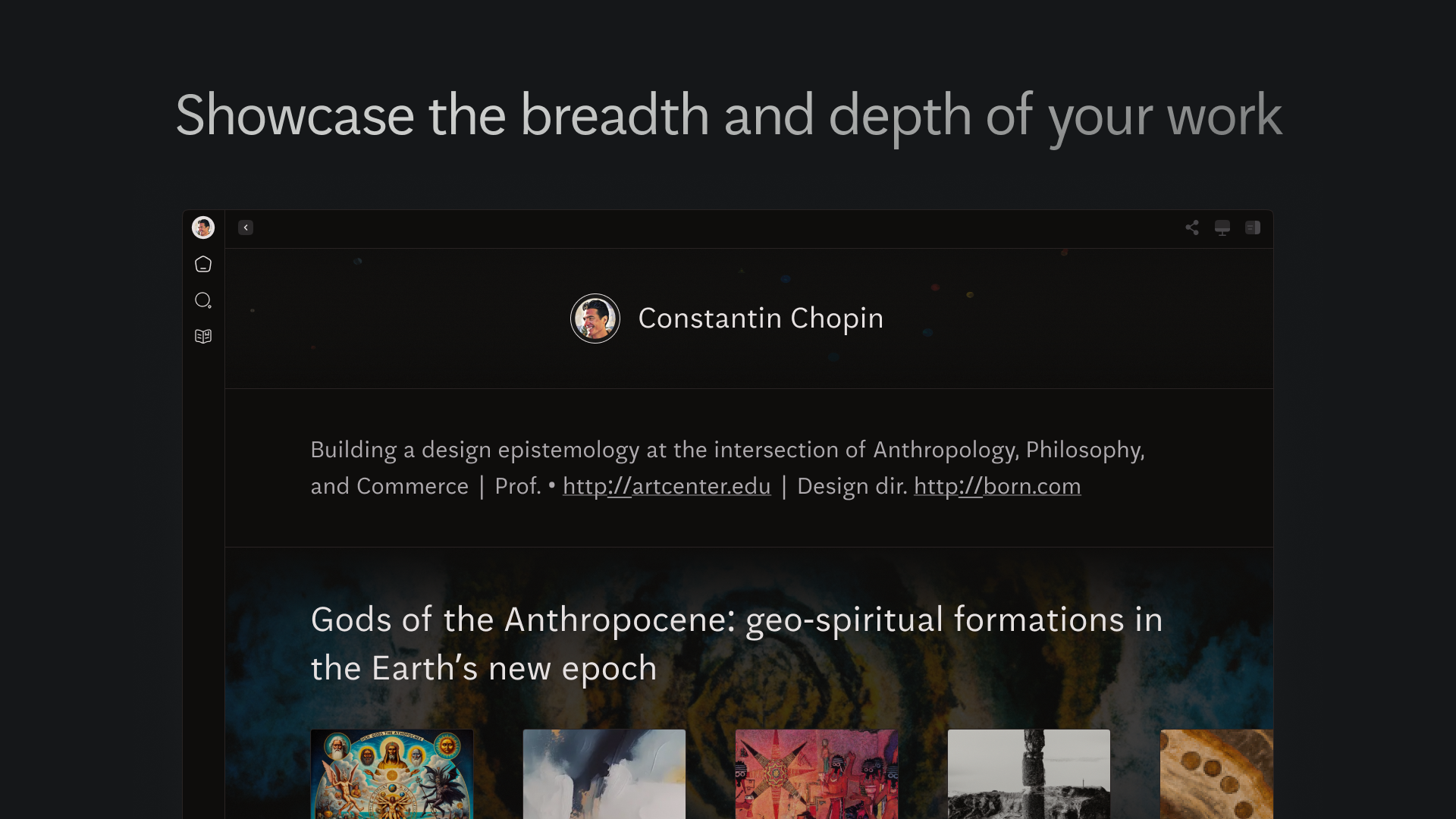Project /
Episteme
AI-assistant for the documentation and showcase of creative and academic projects.
Written by Constantin Chopin
Edited Manon Limousis-Gayda
Product Strategy & UX: Constantin Chopin, Manon Limousis Gayda
Brand Design: Constantin Chopin
Visual Design: Constantin Chopin
13/08/2023
20min read

︎︎︎ Since the revolution of thought that ensued after Galileo’s observation in the early 1600’s. Where Earth was presented not as the center of the universe; a radical shift from the well-accepted geo-centric model. Synthesizing abstract concepts and publishing original perspectives - changing the way people see and understand the world, its mechanics, and their place in it - has never been more prevalent. Indeed, the Galilean revolution had tremendous impact not only in the field of Astronomy, but also on an array of domain of the human sciences such as:
-
Philosophy: The Galilean shift spurred a transition from medieval to modern thought, influencing philosophers like Descartes and Locke to prioritize empirical observation.
-
Theology: Heliocentrism challenged religious views of Earth's centrality, prompting debates and an eventual reconciliation between the Church and science.
- Physics: Galileo's studies, such as his experiments in Pisa, laid groundwork for Newton's laws and modern physics.
- Mathematics: The complexities of describing planetary movements bolstered advancements like Kepler's work on orbits and Newton's development of calculus.
- Literature: Scientific revelations inspired writers, evident in works like Milton's "Paradise Lost" that reflected the changed cosmic perspective.
- Art: The revised view of the universe influenced Renaissance and Baroque art, with artists like da Vinci merging scientific accuracy with their craft.
Naturally, Galileo’s observation is not the only evidence for such a concept. Contemporary historical records provides many examples across domains of knowledge where observations or encounters, once processed, communicated, critiqued, and revised, led to instances of paradigm shift. For example:
- Germ Theory: The idea that germs cause diseases revolutionized healthcare.
- Mendel's Genetics: Mendel's pea plant studies laid the foundation for understanding heredity.
- Radioactivity: Discoveries about radioactive decay changed our view of atomic structure.
- Plate Tectonics: Observations about continents and seismic activity led to the theory of shifting plates.
- Quantum Mechanics: Insights into subatomic behaviors reshaped physics.
- Penicillin's Discovery: Fleming's observation ushered in the antibiotic era.
- Big Bang Theory: Data on cosmic radiation and redshift supported a singular universe origin.
- Cognitive Psychology: A shift from behaviorism to studying internal thought processes.
- Digital Revolution: The rise of binary code-driven computers transformed modern life.
“Value can be found in breathing magic into the processes for how thought-provoking creative and academic endeavours are showcased. Ultimately re-thinking how creative professionals and academics illustrate and share their thoughts in a dedicated and connected environment.”
From these examples, one can see that scientific, phylosophical, and religious view-points evolve and are revised over time based on new information (as it should). While the transition from a mythological to a logical way of thinking ushered in by Greek philosophers (amongst others) provided much of the foundation for a prism through which we look at the world today. Our ability to think, to make, and to communicate our findings, we believe, is nothing short of a desire to contribute to a larger conversation. One that considers: if the universe is the answer, what are the questions we should be asking to understand its very nature?
Admittedly, ‘objects’ such as stories, articles, thesis, theories, and designs; contributing to paradigm shifts often are of a fragmented and highly specific nature. This means that; (1) they carry large amounts of information, (2) employ a jargon that prevents ‘non-experts’ from fully grasping the ideas depicted. Consequently, both implications; (1) information density, and (2) information specificity; lead to one’s struggling in accessing and assimilating nuances and complexities necessary to the process of learning something new. While the goal should not be to turn everyone into an expert of everything. Neither removing any ‘effort’ associated with the process of understanding. Value could be found in breathing magic into the processes for how thought-provoking creative and academic endeavours are showcased. Ultimately re-thinking how creative professionals and academics illustrate and share their thoughts in a dedicated and connected environment. An opportunity to pushing back against highly polarised conversations, and elevating our creative intelligence.
In this case-study, we’ll breakdown the process for creating our latest product: Episteme. Episteme is an AI-assistant for creative professionals and academics. Its purpose being to simplify the documentation and presentation of their work’s life-cycle. In order to do so we’ll break down the essay in two parts:
- The Episteme Brand
- The Episteme Product
Let’s dive in!
︎
From 2017 to 2019, I (Constantin) embarked on my latest academic venture, an MFA at ArtCenter College of Design. Specializing in the domains of Brand and Product Design. This period was punctuated by the cyclical production of vast amounts of information. From design iteration to projects final form, the number concepts explored was endless. Where only one in 100 ideas really made the cut in the end.
My master's completed, I remained invested in the academic community, enlisting as faculty for the very program I had recently graduated from. 5 years, and 200+ students mentored later. It dawned on me that the self-publishing space was ripe for disruption.
As a catalyst for information showcase, sharing, and connection, social media hacked our psyche, rendering us obsessed with games of transaction, engagement, and productivity.
While certain platforms like TEDx do celebrate ideas worth sharing, the contemporary product-scape does not offer solutions to an obvious and growing issue. The fragmented and highly specific nature and format of the work researchers, writers, artists, designers, scientists and engineers produce fails to deliver its substance simply and at scale across contemporary communication pathways. The issue remains, how can creative professionals and academics simply illustrate and share their thoughts in a connected-environment?
1.
![]()
To build the Episteme brand, we leveraged our O.M.P.A.I.A framework. For those curious about this framework; check-out our detailed explanation here: [Brand prism builder. Learn to master the art of brand design leveraging systems thinking.︎︎︎]
Today, the multitude of social media, self-promotion, and publishing channels available fall short of meeting the multifaceted requirements of academics and creative workers. These requirements include but are not limited to:![Competitor matrix showing Episteme versus Dribbble, Instagram, X, Medium, and Academia across two axis. (1) Visually engaging work showcase, and (2) Creation and dissemination of knowledge.]() With this in mind, contemporary
social media, self-promotion, and publishing channels’ limitations for creative professionals and academics become apparent:
With this in mind, contemporary
social media, self-promotion, and publishing channels’ limitations for creative professionals and academics become apparent:
Episteme distinguishes itself from other platforms as it has been designed specifically with the needs of creative professionals and academics in mind. Situating the brand in a space serving individuals who; (1) possess a large body of work, and (2) care for how that body of work is presented and shared with people whithin and outside their communities. And celebrating core subjects of the Human Sciences such as; Archeology, Art, Design, History, Litterature, Philosophy, Religion, Science, and Technology. The Episteme product provides both interface and experience; allowing knowledge makers to organize and present the breadth and depth of their work in a dedicated and connected environment.
We believe in an interdisciplinary, and transformative approach for creativity where practices and notions intentionally blends with one an other. We celebrate stories and experiences, facts and fiction; as a step towards better understanding our universe, and our place in it.
![]()
The Episteme Brand.

To build the Episteme brand, we leveraged our O.M.P.A.I.A framework. For those curious about this framework; check-out our detailed explanation here: [Brand prism builder. Learn to master the art of brand design leveraging systems thinking.︎︎︎]
Today, the multitude of social media, self-promotion, and publishing channels available fall short of meeting the multifaceted requirements of academics and creative workers. These requirements include but are not limited to:
- Nuanced communication: They need to communicate complex ideas, projects, theories etc. This requires more than short posts/snippets and space for nuance.
- Conceptual depth: Professionals/scholars work at a level of depth and rigor that platforms and formats built for casual sharing may not accommodate.
- Visual representations: Professionals need to illustrate their thoughts spotlighting selected areas of their work.
- Context building: They require interfaces that allow providing backstories, explanations, inspirations etc to build context around their projects.
- Critical discussions: Seek constructive peer reviews, debates and discussions around core aspects of their work to evolve/refine their ideas and outputs.
- Knowledge sharing: Need to disseminate what they know and what they are passionate about through thorough and engaging formats.
- Project documentation: A space to comprehensively document long-term or multifaceted projects that evolve through various stages.
- Professional gravitas: Want platforms where they can build authority and repute among peers for career growth.
- Archiving work: Require spaces where their portfolio of work and achievements can be stored securely and permanently.
 With this in mind, contemporary
social media, self-promotion, and publishing channels’ limitations for creative professionals and academics become apparent:
With this in mind, contemporary
social media, self-promotion, and publishing channels’ limitations for creative professionals and academics become apparent:- Twitter, despite its widespread reach, is hindered by its character constraints, curtailing nuanced communication and conceptual depth. Threads, though allowing continuity, can lead to fragmentation, posing challenges in context-building and comprehensive project documentation.
- Dribbble, while a hub for designers, tends to sideline conceptual depth for quick visual impressions, limiting its capacity for in-depth discussions and project narration.
- Medium's strength in long-form content is undermined when catering to specialized professionals, lacking intricate visual tools and structured archiving.
- Academia, tailored for scholars, often misses broader context appealing mainly to academic rigor, making it less versatile for creative professionals.
- Instagram, while visually dominant, offers snapshots rather than comprehensive dives, making nuanced knowledge sharing and project documentation challenging.
“Episteme was born out of the desire to augment the creation and dissemination of knowledge.”
Episteme distinguishes itself from other platforms as it has been designed specifically with the needs of creative professionals and academics in mind. Situating the brand in a space serving individuals who; (1) possess a large body of work, and (2) care for how that body of work is presented and shared with people whithin and outside their communities. And celebrating core subjects of the Human Sciences such as; Archeology, Art, Design, History, Litterature, Philosophy, Religion, Science, and Technology. The Episteme product provides both interface and experience; allowing knowledge makers to organize and present the breadth and depth of their work in a dedicated and connected environment.
“Episteme is a better place for creative and intellectual exploration; it allows researchers, writers, artists, designers, film makers, and engineers to document and share the breadth and depth of their work in a dedicated and connected environment.”
We believe in an interdisciplinary, and transformative approach for creativity where practices and notions intentionally blends with one an other. We celebrate stories and experiences, facts and fiction; as a step towards better understanding our universe, and our place in it.

︎
2.
Problem Statement
The challenge Episteme tackles is two-fold: Firstly, the intricate and specialized nature of modern academic and creative work often makes it inaccessible to wider audiences. Secondly, existing platforms like Twitter, Dribbble, and Academia fall short in presenting this complex work in a comprehensive and engaging manner. These platforms, while popular, are not tailored to the nuanced needs of academics and creatives, leading to a loss in the depth and context of shared knowledge.
User Needs
Users in the academic and creative fields require a platform where they can effectively document, present, and share their work without compromising on its depth and nuance. They need tools that facilitate not just the sharing of information, but also the building of a context around it, encouraging deeper engagement and understanding.
Design Process
The design of Episteme was driven by a thorough understanding of these user needs. The process involved extensive research into the limitations of current platforms, followed by iterative design and testing phases. The aim was to create an AI-assisted environment that intuitively understands the needs of its users and offers a seamless experience in documenting and showcasing complex projects.
Product Features
In-Depth Exploration: Allows users to delve deeply into topics, offering rich multimedia documentation and contextual data.
![]()
Nuanced Communication Tools: Facilitates the expression of complex ideas through sophisticated text and visual tools.
![]()
Seemless data manipulation: Allows users to easily import files from an array of format, further refining their contents, structure, and visual illustration.
![]()
Professional gravitas: A dedicated environment where they can build authority and repute among peers for career growth.
![]()
The Episteme Product. A new standard for intellectual and creative expression.
Problem Statement
The challenge Episteme tackles is two-fold: Firstly, the intricate and specialized nature of modern academic and creative work often makes it inaccessible to wider audiences. Secondly, existing platforms like Twitter, Dribbble, and Academia fall short in presenting this complex work in a comprehensive and engaging manner. These platforms, while popular, are not tailored to the nuanced needs of academics and creatives, leading to a loss in the depth and context of shared knowledge.
User Needs
Users in the academic and creative fields require a platform where they can effectively document, present, and share their work without compromising on its depth and nuance. They need tools that facilitate not just the sharing of information, but also the building of a context around it, encouraging deeper engagement and understanding.
Design Process
The design of Episteme was driven by a thorough understanding of these user needs. The process involved extensive research into the limitations of current platforms, followed by iterative design and testing phases. The aim was to create an AI-assisted environment that intuitively understands the needs of its users and offers a seamless experience in documenting and showcasing complex projects.
Product Features
In-Depth Exploration: Allows users to delve deeply into topics, offering rich multimedia documentation and contextual data.

Nuanced Communication Tools: Facilitates the expression of complex ideas through sophisticated text and visual tools.

Seemless data manipulation: Allows users to easily import files from an array of format, further refining their contents, structure, and visual illustration.

Professional gravitas: A dedicated environment where they can build authority and repute among peers for career growth.
